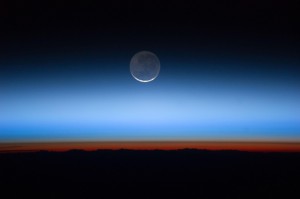…So Is It Made Out of Bleu Cheese?
July 31, 2015

A full moon rises over Earth in a photo take from the International Space Station. Tonight, the second full moon of the month—the blue moon—will appear in the sky. (c NASA)
Is it the second full moon in a month? The third full moon in a season that has four full moons? An uncommon occurrence? A crazy idea? Over the years, the term “blue moon” has held many definitions. The definition that includes tonight’s full moon is a relatively recent—and accidental—invention.
As early as 1528, “blue moon” was a phrase used to mean a silly belief. In later times, people described uncommon events as occurring “once in a blue moon.” Additional definitions of the term refer to rare types of full moons. According to one definition, a blue moon is the second full moon in a month that has two full moons. According to an older definition, a blue moon is the third full moon in a season that has four full moons. The older definition was developed using a calendar in which spring always begins on March 21. In this calendar, the beginnings of summer, autumn, and winter are based on the position of an imaginary sun called the dynamical mean sun. Today, astronomers use a different rule for determining the beginnings of the seasons.
In the early 1900′s, the Maine Farmers’ Almanac published dates on which blue moons would appear, using the older definition. The newer definition of the second full moon in a month originated in Sky & Telescope magazine in 1946. Other publications adopted the definition, and many people came to accept it. In 1999, however, Sky & Telescope published an article explaining that the 1946 definition actually originated from a misreading of the Maine Farmers’ Almanac.
For all this talk about “blue” moons, can the moon ever actually turn the color blue? If certain tiny particles are in the atmosphere, the moon can, in fact, appear blue. Volcanoes and forest fires are the most common sources of these particles. For example, when the Indonesian volcano Krakatau erupted in 1883, people around the world reported seeing a blue-hued moon for years afterward. Such events are rare, however, so true blue moons could be said to only occur once in a blue moon! Confused yet?
Other links:


